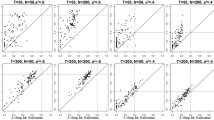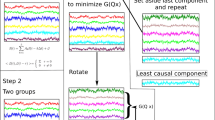Abstract
A new approach to the genetic analysis of time series of arbitrary length and with arbitrary covariance function is outlined. This approach is based on the simultaneous eigenvalue decomposition of the covariance matrices of the original time series obtained from monozygotic (MZ) and dizygotic (DZ) twins. The method is illustrated with computer-simulated twin data.
Similar content being viewed by others
References
Ahmed, N., and Rao, K. R. (1975).Orthogonal Transforms for Digital Signal Processing, Springer-Verlag, New York.
Boomsma, D. I., and Molenaar, P. C. M. (1987). The genetic analysis of repeated measures. I: Simplex models.Behav. Genet. 17:111–123.
Box, G. E. P. (1954). Some theorems on quadratic forms applied in the study of analysis of variance problems. II. Effects of inequality of variance and of correlation between errors in the two-way classification.Ann. Math. Stat. 25:484–498.
Box, G. E. P., and Jenkins, G. M. (1976).Time Series Analysis, Forecasting and Control, Holden-Day, San Erancisco.
Brillinger, D. R. (1975).Time Series: Data Analysis and Theory, Holt, Rinehart & Winston, New York.
Granger, C. W. J., and Morris, M. J. (1976). Time series modeling and interpretation.J. Roy. Stat. Soc. A 139:246–257.
IMSL, Inc. (1979).IMSL Library Reference Manual Edition 7, IMSL, Inc., Houston, Tex.
Jenkins, G. M., and Watts, D. G. (1968).Spectrum Analysis and Its Applications Holden-Day, San Francisco.
Kashyap, R. L., and Rao, A. R. (1976).Dynamic Stochastic Models from Empirical Data, Academic Press, New York.
Lutzenberger, W., Elbert T., Rockstroh, B., and Birbaumer, N. (1980). Biofeedback of slow cortical potentials. II. Analysis of single event-related potentials by time-series analysis.Electroenceph. Clin. Neurophysiol. 48:302–311.
Martin, N. G., and Eaves, L. J. (1977). The genetical analysis of covariance structure.Heredity 38:79–95.
Molenaar, P. C. M. (1981).Dynamische factormodellen, doctoral dissertation, State University of Utrecht, Utrecht (in Dutch).
Molenaar, P. C. M. (1985). A dynamic factor model for the analysis of multivariate time series.Psychometrika 50:181–202.
Morrison, D. F. (1976),Multivariate Statistical Methods, McGraw-Hill, Kogakusha, Tokyo.
Stobberingh, R. (1972).Dynamische componenten analyse, een intergrative van componenten-en tijdreeksanalyse, doctoral dissertation, Catholic University, Tilburg (in Dutch).
Wastell, D. G. (1981). On the correlated nature of evoked brain activity: Biophysical and statistical considerations. In Gaillard, A. W. K., and Ritter, E. (eds.),Tutorials in ERP Research: Endogenous Components, North-Holland, Amsterdam.
Author information
Authors and Affiliations
Rights and permissions
About this article
Cite this article
Molenaar, P.C.M., Boomsma, D.I. The genetic analysis of repeated measures. II the Karhunen-Loève expansion. Behav Genet 17, 229–242 (1987). https://doi.org/10.1007/BF01065503
Received:
Accepted:
Issue Date:
DOI: https://doi.org/10.1007/BF01065503




